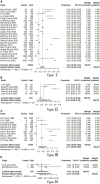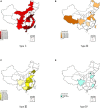Prevalence of violence to others among individuals with schizophrenia in China: A systematic review and meta-analysis
- PMID: 35935404
- PMCID: PMC9354073
- DOI: 10.3389/fpsyt.2022.939329
Prevalence of violence to others among individuals with schizophrenia in China: A systematic review and meta-analysis
Abstract
Background: Violence to others (hereinafter referred to as "violence-TO") is common in individuals with schizophrenia. The reported prevalence of violence-TO among schizophrenics ranges widely in existing studies. Improved prevalence estimates and identification of moderators are needed to guide future management and research.
Methods: We searched EBSCO, EMBASE, Medline, PubMed, Science Direct, Web of Science, CNKI, VIP, WANFANG data, and CBM for relevant articles published before June 5, 2022. Meanwhile, violence-TO was summarized into four categories: (a) violence-TO on the reviews of official criminal or psychiatric records (type I); (b) less serious forms of violence-TO (type II); (c) physical acts causing demonstrable harm to victims (type III); (d) homicide (type IV). We did meta-analysis for the above types of violence-TO, respectively, and applied subgroup analyses and meta-regression analyses to investigate the source of heterogeneity.
Results: A total of 56 studies were eligible in this study and 34 of them were high-quality. The prevalence of type I to type IV in individuals with schizophrenia in China was 23.83% (95% CI: 18.38-29.75%), 23.16% (95% CI: 8.04-42.97%), 17.19% (95%CI: 8.52-28.04%), and 0.62% (95% CI: 0.08-1.54%) respectively. The results of the subgroup analysis showed that the prevalence of type I was higher among subjects in the inland than in the coastal non-economic zone, while the prevalence of type III was the highest in the coastal economic zone, followed by the inland region and the lowest in the coastal non-economic zone. The results of multivariate meta-regression analyses showed that: patient source in type I (β = 0.15, P < 0.01), patient source (β = 0.47, P < 0.01), and proportion of male (β = 0.19, P < 0.01) in type II, age (β = 0.25, P < 0.01), and GDP per capita (β = 0.05, P = 0.01) in type III were statistically significant.
Conclusion: The prevalence of different types of violence-TO and their influencing factors varied. Therefore, the authorities should take different management measures. In addition to individual factors, regional factors may also affect violence-TO, which suggests the need for a multi-sectorial approach to prevention and treatment for subjects in different regions and adopting targeted control strategies.
Systematic review registration: [www.ClinicalTrials.gov], identifier [CRD42021269767].
Keywords: meta-analysis; prevalence; schizophreina; spatial distribution; violence.
Copyright © 2022 Guo, Yang, Wang, Fan, Liang, Wang, Xiang, Liu and Liu.
Conflict of interest statement
The authors declare that the research was conducted in the absence of any commercial or financial relationships that could be construed as a potential conflict of interest.
Figures



Similar articles
-
Prevalence of suicide ideation, self-harm, and suicide among Chinese patients with schizophrenia: a systematic review and meta-analysis.Front Public Health. 2023 May 2;11:1097098. doi: 10.3389/fpubh.2023.1097098. eCollection 2023. Front Public Health. 2023. PMID: 37200989 Free PMC article.
-
The effect of exposure to long working hours on stroke: A systematic review and meta-analysis from the WHO/ILO Joint Estimates of the Work-related Burden of Disease and Injury.Environ Int. 2020 Sep;142:105746. doi: 10.1016/j.envint.2020.105746. Epub 2020 Jun 3. Environ Int. 2020. PMID: 32505015
-
Deployment of personnel to military operations: impact on mental health and social functioning.Campbell Syst Rev. 2018 Jun 1;14(1):1-127. doi: 10.4073/csr.2018.6. eCollection 2018. Campbell Syst Rev. 2018. PMID: 37131363 Free PMC article.
-
Community-based care for the specialized management of heart failure: an evidence-based analysis.Ont Health Technol Assess Ser. 2009;9(17):1-42. Epub 2009 Nov 1. Ont Health Technol Assess Ser. 2009. PMID: 23074521 Free PMC article.
-
Prevalence and Risk Factors of Functional Constipation According to the Rome Criteria in China: A Systematic Review and Meta-Analysis.Front Med (Lausanne). 2022 Feb 16;9:815156. doi: 10.3389/fmed.2022.815156. eCollection 2022. Front Med (Lausanne). 2022. PMID: 35252254 Free PMC article.
Cited by
-
Risk factors for violent behaviors in patients with schizophrenia: 2-year follow-up study in primary mental health care in China.Front Psychiatry. 2023 Jan 20;13:947987. doi: 10.3389/fpsyt.2022.947987. eCollection 2022. Front Psychiatry. 2023. PMID: 36741582 Free PMC article.
-
Stigmatization of schizophrenic individuals and its correlation to the fear of violent offence. Should we be concerned?Ann Med Surg (Lond). 2022 Sep 19;82:104666. doi: 10.1016/j.amsu.2022.104666. eCollection 2022 Oct. Ann Med Surg (Lond). 2022. PMID: 36268356 Free PMC article. No abstract available.
-
Machine Learning for prediction of violent behaviors in schizophrenia spectrum disorders: a systematic review.Front Psychiatry. 2024 Mar 21;15:1384828. doi: 10.3389/fpsyt.2024.1384828. eCollection 2024. Front Psychiatry. 2024. PMID: 38577400 Free PMC article.
-
Cross-cultural adaptation of the family coping questionnaire and psychometric evaluation among caregivers of schizophrenic patients in China.BMC Nurs. 2025 Jul 5;24(1):853. doi: 10.1186/s12912-025-03534-7. BMC Nurs. 2025. PMID: 40618043 Free PMC article.
-
Investigation of peripheral inflammatory biomarkers in association with violence in schizophrenia.BMC Psychiatry. 2024 Jul 31;24(1):542. doi: 10.1186/s12888-024-05966-y. BMC Psychiatry. 2024. PMID: 39085826 Free PMC article.
References
-
- IHME. Global Health Data Exchange GBD 2019. (2019). Available online at: https://vizhub.healthdata.org/gbd-compare/ (accessed August 30, 2021).
Publication types
LinkOut - more resources
Full Text Sources

